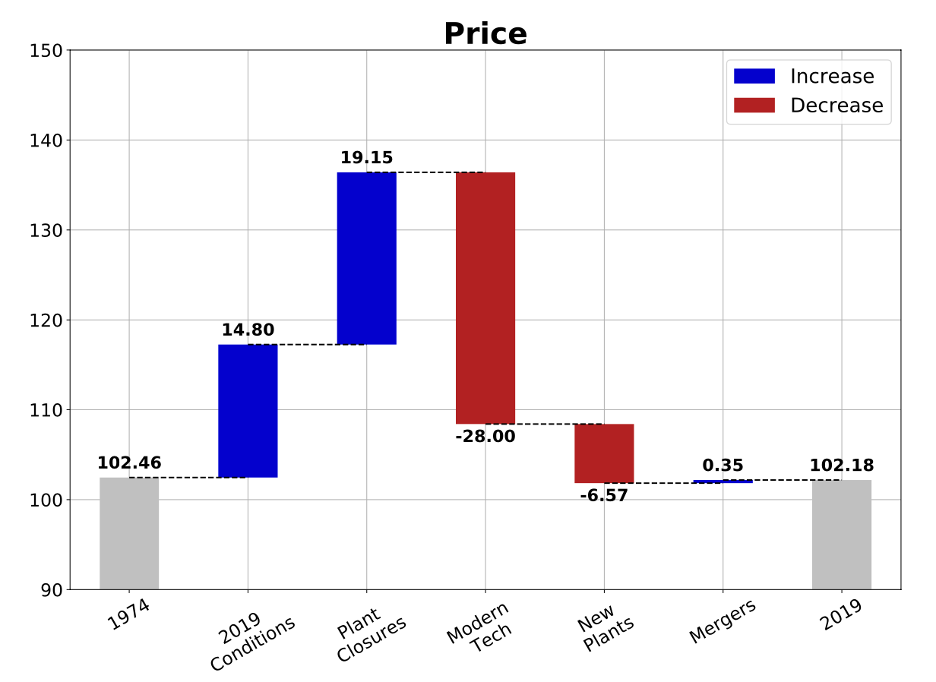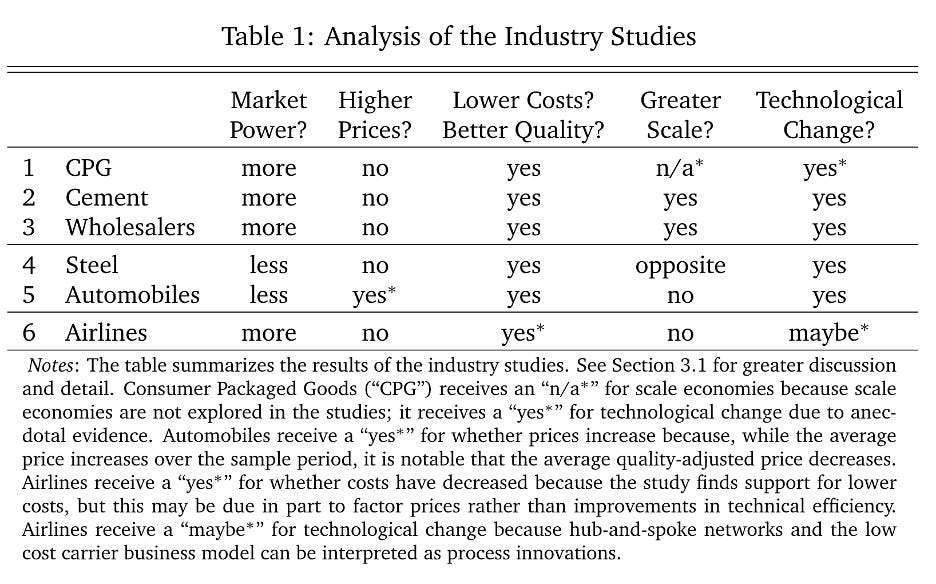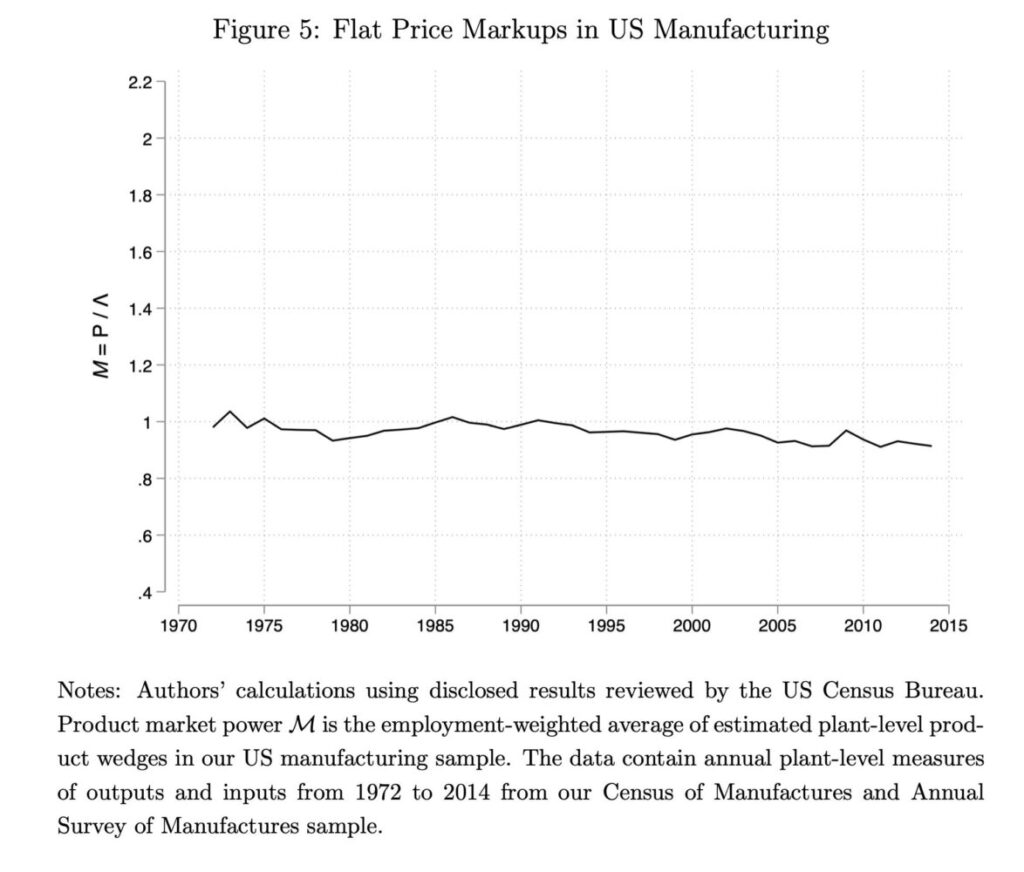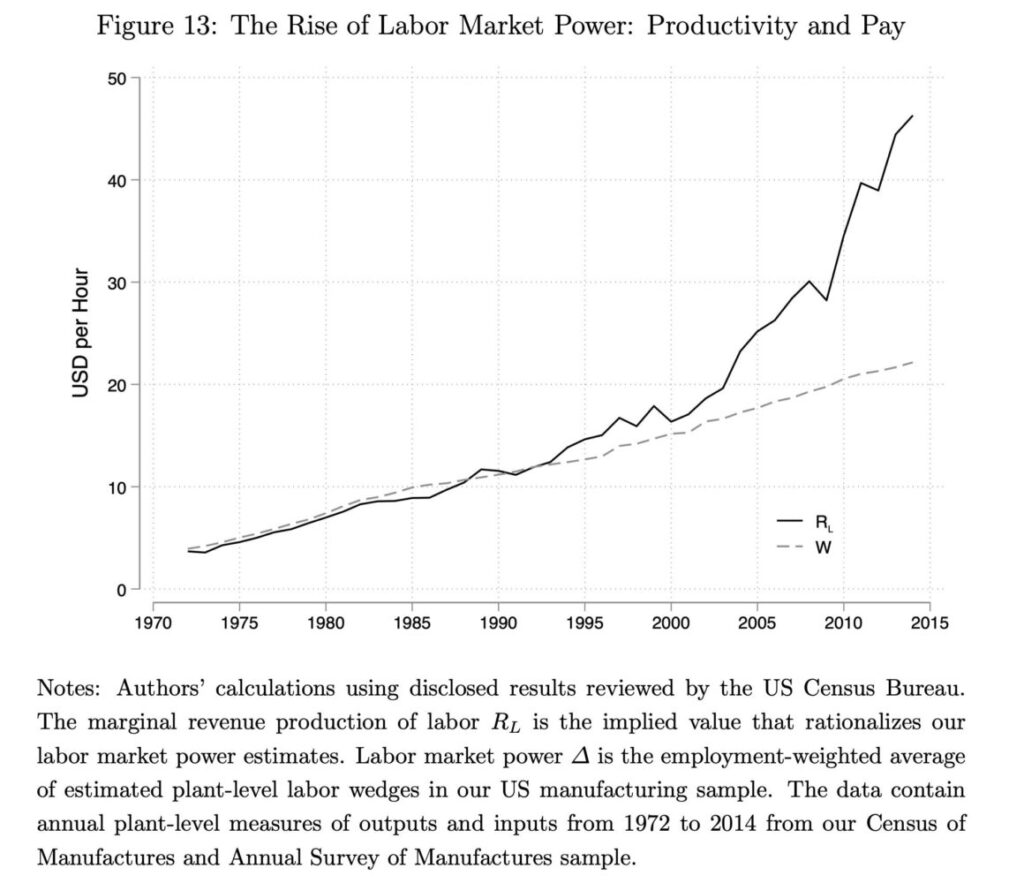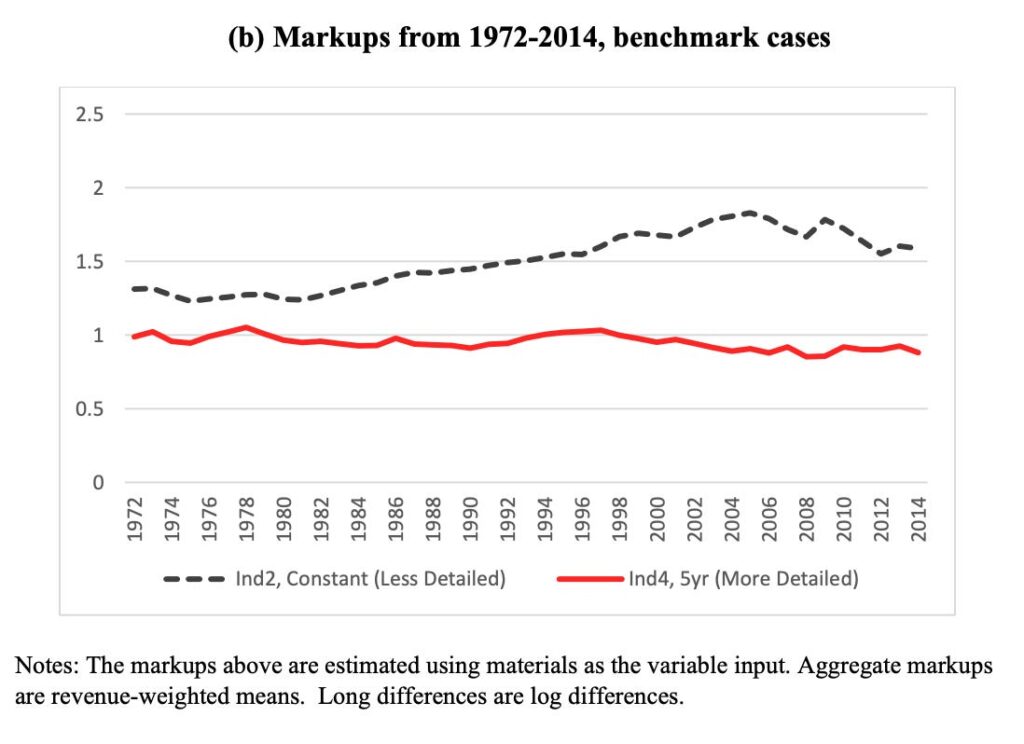
In my research and newsletters, I’ve written about how to interpret markups—mostly on the theory side. I haven’t devoted much space explaining the empirics. How high are markups in the United States? Are they rising? If so, by how much?
This post seeks to answer those questions. I’m writing it after reading a new paper by Nathan Miller on “Industrial Organization and The Rise of Market Power,” which is the most recent literature review. Miller focuses primarily on the markup literature from an industrial-organization (IO) perspective. I’ll have more to say about that later. The paper helped me gather my thoughts, but the interpretations and arguments below are all mine. So read this post, and then read Miller.
Buckle up. It’s about to get nerdy.
De Loecker, Eeckhout, & Unger
A few years ago, the seminal paper by Jan De Loecker, Jan Eeckhout, and Gabriel Unger (for brevity’s sake, I’ll refer to this paper as “DEU”) found that sales-weighted average markups—the difference between selling price and marginal cost—increased significantly from 1980 to 2016. DEU documents a striking trend: The sales-weighted average markup increased from 1.21 in 1980 to 1.61 in 2016, a rise of more than 30%. This is the figure you may have seen. I’ve shared it before.
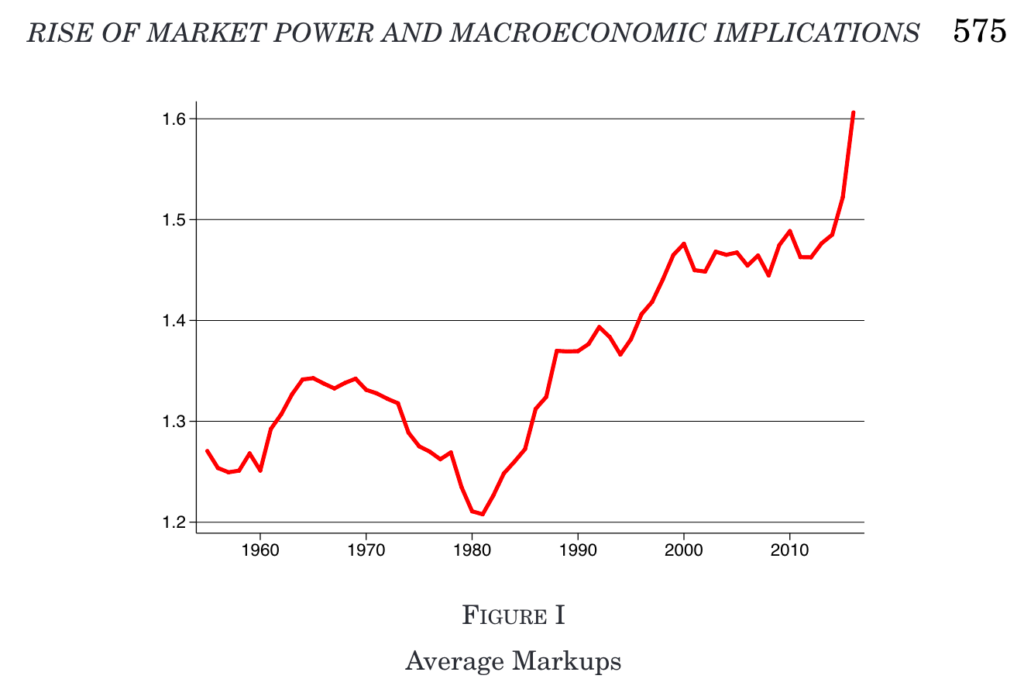
Roughly 2,400 citations later, there is a whole literature on “The Rise of Market Power.” Like many, this literature caught my attention.
How do they get their number? DEU used a “production approach” to estimate markups and applied it to a dataset of publicly traded firms, spanning multiple decades.
Here’s how it works: DEU show (drawing on earlier work) that a firm’s markup is determined by two factors: the revenue share of some input (how much of the firm’s total revenue is spent on that input) and the output elasticity of that input (how much a firm’s output increases with an increase in input). For example, if a factory’s production rises significantly with a small addition of labor, labor for that firm has high output elasticity. When an input significantly boosts output and constitutes a large portion of the firm’s expenses, the firm can generally achieve a higher markup.
Interestingly, this markup calculation does not rely on the market structure or interactions between different sellers; whether the market is competitive, monopolistic, or somewhere in between, the principles of how output elasticity and cost share influence markup remain consistent.
This is a powerful result because it suggests that, if you can estimate the output elasticity and observe the cost share, you can recover the markup without observing prices and marginal costs, which are typically hard to measure.
DEU uses accounting data from Compustat, which provides financial statements for publicly traded U.S. firms. They treat the cost of goods sold (COGS) as the variable input. Then, they estimate the output elasticity using industry-level production functions and make several assumptions to control for the unobserved productivity shocks.
This result made waves for a few reasons.
It was the first evidence using firm-level data of a long-term, broad-based rise in markups. Previous papers had looked at industry concentration or profitability trends, but this was more direct evidence of rising “market power.” That’s really important. Concentration is a bad measure of market power.
The method seemed to provide a simple way to measure markups and market power using accounting data and without needing to estimate demand systems, which meant it could be applied very broadly. This had lots of benefits, but one big one is that you don’t need to assume that the nature of competition is constant across industries or through time. Technology, competition, laws—they can all change. You’re just picking up the outcome. That’s a big deal if you want to talk about markups overall.
The rise was huge—a more than 30% increase in markups is a lot! If true, it would have major implications for welfare, inequality, etc. It coincided with a growing policy debate about rising corporate power, declining competition, and the role of antitrust.
In short, DEU was seen as providing the empirical ammunition that those arguing about a rise in market power needed. It’s no exaggeration to say that it defined the empirical debate about market power.
Responses to the DEU Number
The DEU exercise was very clever and seemed simple enough. But immediately, follow-up papers investigated the same question.
As Nathan Miller points out, the production approach used by DEU faces several empirical challenges inherent to the method and the data it uses. Miller frames the discussion around the Compustat data, unobserved prices and quantities, and demand. I’ll stick with those, but elaborate more and add my take.
Compustat Data
I’ll start with the issue I’ve discussed: the paper relies on Compustat data for publicly available firms. Since the focus is not on concentration measures, Compustat here is not as problematic as in some other papers. But the big issue remains that publicly traded firms are not representative of the whole economy. That matters if you’re trying to say something about the U.S. economy and not about just about U.S. publicly traded firms.
In the appendix, they reweight industries by the Bureau of Economic Analysis weights and find similar trends. That’s helpful, but doesn’t solve the problem that, within each industry, publicly traded firms may look different from the universe of firms overall.
But there are debates about how one uses the accounting data that I haven’t harped on before.
There are questions about the appropriateness of using accounting measures like the cost of goods sold to measure economic concepts like variable costs. While DEU explores alternative measures in robustness checks, this measurement issue interacts with the other challenges in ways that are not fully resolved.
In one of the earliest response papers, James Traina points out that the measure of variable costs the DEU uses (cost of goods sold) may not fully capture all variable costs. In particular, selling, general, and administrative (SG&A) expenses likely include some labor and overhead costs that are flexible inputs that vary with output.
When Traina includes SG&A in the measure of variable costs, he finds that the markup rise largely disappears. In fact, markups appear to have declined in some specifications over the period studied by DEU. This result suggests that the markup increase found by DEU is sensitive to the exact cost measure used.
That’s not great.
Including all SG&A in variable costs is also problematic, however, as it likely includes many fixed costs. The truth probably lies somewhere between—some SG&A is variable, some is fixed. Traina’s paper, however, highlights the sensitivity of the markup trend to the exact cost measurement. In theory, it shouldn’t depend on which measure you use, as long as it is flexible. In practice, Devesh Raval shows that, with even better data from manufacturing, the choice of input matters for the estimation.
Suppose you have good firm-level estimates of markups. You still need a way to aggregate them to an overall number. Chris Edmond, Virgiliu Midrigan, and Daniel Yi Xu (2023) start with a more conceptual point about the welfare implications of rising markups. They show that, in their model, welfare costs depend on the cost-weighted average markup, rather than the sales-weighted average markup that DEU used.
The intuition is that what matters for welfare is how much they distort the allocation of resources. If you weigh companies by sales, high-markup firms may have lower costs and still get a larger sales weight. A high-cost firm with a small markup can, however, create more distortion than a low-cost firm with a large markup.
When Edmond et al. calculated the cost-weighted average markup, they found a more modest increase than the sales-weighted measure. That said, they still find an increase in markups over time, even with the cost-weighted measure.
Their paper is an important reminder that the welfare implications of rising markups depend on why markups are growing, and how they are distributed across firms. A markup increase driven by declining costs has very different consequences than one driven by rising prices. I’ve written about this before.
